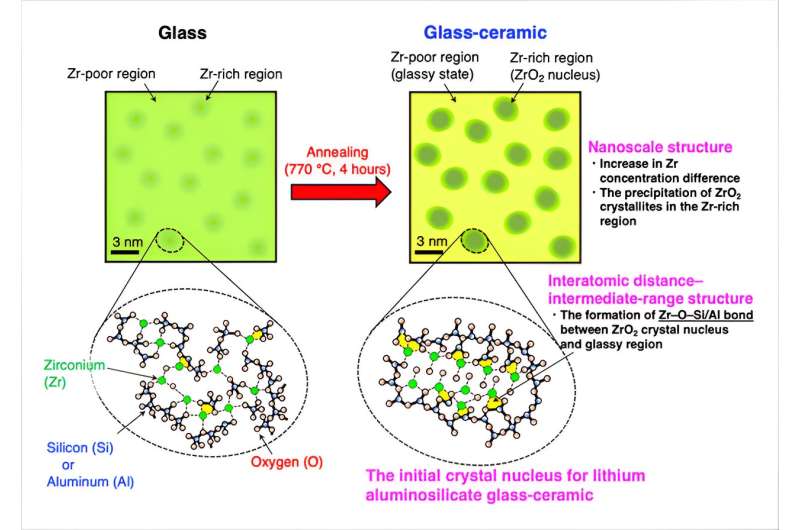This article has been reviewed according to Science X's editorial process and policies. Editors have highlighted the following attributes while ensuring the content's credibility:
fact-checked
trusted source
proofread
Study reveals mechanisms of crystal nucleation in glass-ceramics

A research team consisting of NIMS, AGC Inc., and JASRI has observed partial crystallization of a glass—an initial stage in its transformation into a stronger, more heat resistant glass-ceramic. The study is published in the journal NPG Asia Materials.
To investigate this crystal nucleation process, the team performed multiscale structural analysis mainly using synchrotron X-rays. Based on this analysis, the team developed a model capable of explaining the crystal nucleation mechanisms within a glass at different spatial scales, from atomic to nano, without contradiction.
To obtain a glass-ceramic, it is necessary to synthesize a pristine glass with a composition designed and controlled to precipitate crystals partially through heat treatment. It is believed that in the structure of glass-ceramics, crystal nuclei, which are the seeds of crystals, form within the glass matrix, from which crystal particles grow.
However, the mechanisms behind crystal nucleation and crystal growth during transformation into a glass-ceramic had not been fully understood.
This research team recently observed the initial stage of a glass transformation into a glass-ceramic by performing a multiscale structural analysis mainly using synchrotron X-rays. For this observation, the team selected zirconium oxide (ZrO2)-doped lithium aluminosilicate glasses—the most important and commonly used glasses in practical applications.
Nanoscale structural measurements revealed that heat treatment increases zirconium (Zr) concentration differences between the intrinsically present Zr-rich and Zr-poor regions of the glass. Nanosized crystal nuclei were then found to form within the Zr-rich regions.
In addition, by utilizing measurement techniques capable of observing Zr-specific structures, the team discovered for the first time that Zr–O–Si/Al bonds, where Zr is linked with silicon (Si) and aluminum (Al) through oxygen (O), exist around the ZrO2 crystal nuclei, elucidating the structure of the initial crystal nuclei.
Consequently, they successfully proposed a model that can consistently explain the mechanism of crystal nucleation within the glass from the atomic level to the nanometer scale.
The structural analysis technique employed in this research is applicable to materials in practical use with complicated compositions and disordered atomic arrangements. Using this technique, the team plans to investigate the mechanisms by which various practical materials exhibit unique characteristics.
The insights gained from these investigations may be helpful to synthesize new functional materials with novel characteristics.
More information: Yohei Onodera et al, Formation of a zirconium oxide crystal nucleus in the initial nucleation stage in aluminosilicate glass investigated by X-ray multiscale analysis, NPG Asia Materials (2024). DOI: 10.1038/s41427-024-00542-y
Provided by National Institute for Materials Science





















